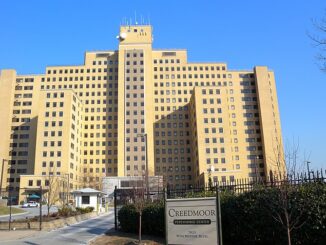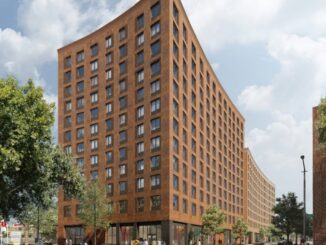
When Merete Muenter tells people that she pays $623 a month for her studio in an affordable housing complex in New York City, many assume the worst: a run-down dump in a crime-ridden neighborhood.
The reality is that her subsidized rental is far nicer than any of the market-rate places she’s lived in previously.
“People … don’t realize that my affordable housing apartment is in a luxury building that has all the amenities that I never dreamed of having, living in midtown Manhattan,” says Muenter. “I have a doorman, elevators, gym, roof terrace, courtyard, even a washer and dryer in my apartment.”
In 2014, this choreographer and director of musical theater landed this windfall by entering an affordable housing lottery. The effect was life-changing.
“It has allowed me to continue to live in the neighborhood I love while working as an artist,” says Muenter. “I no longer feel the stress and struggle of trying to have enough money to pay rent and bills every month—it’s such a relief.”
Friends and family who visit are often shocked by how lovely her place is—and puzzled to learn she even qualified as “needy” enough.
Mike Halden, another affordable housing resident since 2011 who pays $689 for a one-bedroom in the same building, agrees that such misconceptions are common.
“There are all these negative connotations associated with being the ‘class’ or ‘type’ of people who live in these residences—low income, living on welfare, Section 8, homeless, indigents, interlopers,” he says. “I don’t fit into those categories except income. I’m a Caucasian, middle-aged, ex-Broadway dancer on disability because of health issues, yet I’ve experienced this negative perception from other residents firsthand.”
Nonetheless, he says, “I’m very grateful and still a little shocked that I got in and have this great affordable apartment that allowed me to stay in the city and know that I don’t have to move for the next 10, 15, or 20 years.”
Affordable housing: It’s not what you think
In the US, “affordable housing”—an umbrella term encompassing a variety of government-subsidized housing for low-income families—is more widely available than many realize, offering homes at reasonable prices to rent or own throughout the country.
And every day, more are being built, since these residences earn developers a combination of below-market loans, subsidies, and tax incentives. In exchange, those apartments must be exclusively leased or sold to tenants whose incomes are below certain parameters.
While these below-market-rate domiciles are a boon to those who qualify, they’re also mired in misconceptions. At a time when housing has become unaffordable for more Americans than ever, it’s crucial to set the record straight on affordable housing, who qualifies, and where to find it.
We asked experts to shed light on some of the biggest fallacies surrounding subsidized housing and offer some surprising reality checks. Read on to see if you’ve fallen for any of these affordable housing myths yourself—and learn the truth.
Affordable housing is ‘the projects’
“The biggest myth or issue for me is that people conflate affordable housing with public housing,” says affordable housing attorney Amanda Huegerich.
In general, when real estate professionals discuss affordable housing, they’re talking about Section 42 housing, which are units built by private developers who are hoping to capitalize on low-income housing tax credits, or LIHTC. These developers construct a certain number of units to sell or rent at reduced rates to people in need.
Section 42 housing differs from public housing, which is government-sponsored buildings constructed, owned, and run by local public housing authorities. It also differs from Section 8 vouchers, which are federal housing support subsidies given to very low-income residents to help make up a portion of their rent payments.
“Affordable housing has many different categories, and the general public most often confuses Section 42 housing with Section 8,” says Yun Tong, vice president and senior project manager of LIHTC Equity and Debt Investments for U.S. Bank.
Affordable housing is only for the destitute
Section 42 housing units are financed to support lower-income households, which may include salaries that are not what many would consider “poor.”
Applicants qualify by earning less than the area median income, or AMI, a metric used by the US Department of Housing and Urban Development. It is adjusted annually and varies by area.
“Affordable housing is income-restricted based on the average median incomes in a particular county,” says Roxanne Nicolas, vice president of Hudson Housing Capital, an LIHTC syndicator based in New York City. “The program allows for tenants up to 80% of average median income, which means that working-class and middle-class households can often qualify.”
For example, in New York City, someone making 80% AMI would be making $79,120 annually as a single person or $90,400 as a couple. That’s hardly chump change.
“Few people understand that the majority of people qualify for affordable housing of some sort,” says Huegerich. “There’s this misconception that it’s for those people when it’s actually for all of us, or at least most of us.”
Affordable housing brings crime and lowers real estate values
Affordable housing developments are often met with resistance from current residents, reflected in the NIMBY movement. This “Not In My Backyard” opposition is due to fears that such residences will bring crime and drugs to the area—or lower real estate values.
But some studies show the opposite to be true.
A 2022 study by the University of California at Irvine found that when affordable housing units were built in Orange County, crime rates went down and property values went up by $16,000 on average.
“Many low-income housing tax credit deals are for seniors, which certainly won’t increase crime rates,” says Nicolas.
“We research crime rates in the areas where we’re investing, and some of the locations where we invest are higher crime areas and we need to make sure there are sufficient safety measures in place to ensure that residents are safe,” adds Nicolas. “But it’s more residents needing to be safe from any nearby crime than residents being the cause of the crime.”
“I don’t think people realize what they’re saying ‘not in my backyard’ to,” adds Huegerich.
Affordable housing is basic and bare-bones
People often envision affordable housing as a drab dwelling built to minimal standards. But nothing could be further from the truth.
“Real estate developers must submit an application and generally must go through a competitive process in order to be awarded low-income housing tax credits that can be used to finance affordable housing properties,” says Nicolas.
“In order to have a competitive application, developers must commit to offering unit and project amenities that are often found in market-rate properties, which can include in-unit washers and dryers, dishwashers, community rooms, and picnic areas.”
The Vue at Weschester Commons in Midlothian, VA, is a perfect example of how posh affordable housing can be, Huegerich says.
“You drive by these buildings on the highway, and they look high-quality. You’re like, ‘Wow, that’s a gorgeous apartment complex,’” says Huegerich. “Every single one of those apartments is considered an affordable housing development—every single one of them, and they are absolutely stunning.”
Affordable housing is built in undesirable areas
Another common assumption is that affordable housing is located in less desirable locales. Once again, this is not the case.
“Properties financed with the low-income housing tax credit are located in a broad range of socioeconomic locations,” says Nicolas. “In 2023, I helped underwrite a project located in a highly desirable neighborhood of Seattle that was the rehabilitation of a building originally built in the 1920s.”
Another thing to note is that zoning in a certain geographic area may require a developer to include a certain number of affordable housing units.
“Let’s say a developer is coming into Northern Virginia and they’re going to build 144 units. The zoning board for that area may say, ‘We need to see that X number are affordable’ in order for the project to be approved,’” says Huegerich.
It doesn’t matter if it’s an affluent area or not. If developers want the permit, they have to build the units.
Affordable housing isn’t lucrative for developers
Builders are not including affordable housing out of the kindness of their hearts: While some builders are committed to offering more affordable housing, they’re also making money from these developments.
“Affordable housing developers make a lot of money—they’re millionaires and we’re making millionaires richer with their affordable housing projects,” says Huegerich.
If you win an affordable housing lottery, you automatically get in
Most affordable housing programs receive more applicants than they can accommodate, so they use a lottery system to help select recipients. If you apply and your number’s called, that’s exciting—but it’s only one step in the process without guaranteeing you’re in.
“Even though your name was pulled in the housing lottery, it doesn’t mean that you have automatically gotten an apartment,” says Muenter. “You have to go through a very stringent application process once your name is drawn, and it’s way more involved than just showing a few recent pay stubs.”
She advises applicants for affordable housing to monitor, save, and organize their financial information and have it ready in case they make it to the next step.
Halden agrees, adding, “I know a lot of people drop out during the application process because acquiring all the documentation of income required can be overwhelming. When you’re trying to hit a certain income requirement, they factor in every penny, so it is important to make sure everything is listed correctly and that every cent is counted, because it does matter.”
You’ll be kicked out of your affordable housing if your income rises
Generally, an affordable housing unit cannot be taken away if the tenant suddenly has a banner year financially.
“Fortunately, they can’t do anything to you in my building if you suddenly win a million dollars in the lottery,” says Muenter. “They still consider your financial situation for the time that you qualified and moved into the apartment when your lease is renewed.”
However, many of these developments require residents to show proof of their income every year. This is done so the building can prove it’s in compliance with the terms of its affordable housing provisions. In certain buildings, a higher income could affect how much you pay in rent.
“I do have to get recertified every year by the building management and that can be a pain, but again, it’s worth it if it means being able to live in this nice building in the neighborhood that I love so much,” says Muenter.
There are no affordable housing opportunities in my area
Affordable housing is widely available across the US.
“Look at the housing finance agencies in your state, and find out what builds have affordable housing units in them,” suggests Heugerich.
Check out this HUD Resource Locator, which maps out affordable housing agencies by area. Or try an internet search for affordable housing opportunities or lotteries in your area.
Real Estate – Latest NYC, US & Celebrity News



